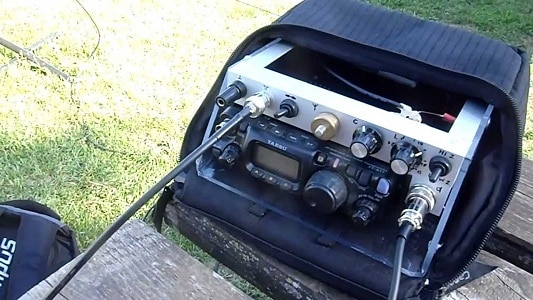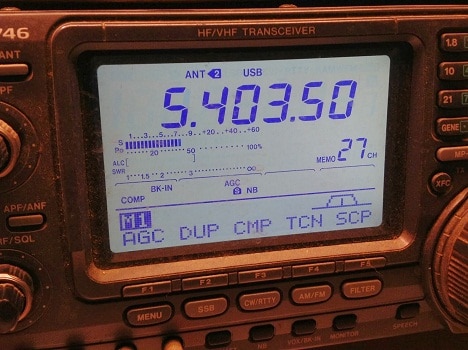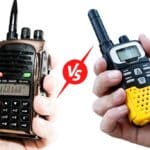Amateur radio is an engaging hobby that can be practiced by anybody who wants to apply for a license and buy a radio transceiver.
However, there is great depth to this hobby, and it’s easy to get overwhelmed.
This article will function as a life jacket to keep your head above water until you’re ready to dive into more advanced ham-radio knowledge!
What is Ham Radio?
Radio is a form of non-ionizing electromagnetic radiation that is easily used to transmit information through the air and through some objects.
Your car’s stereo receives radio. Pilots and boat skippers use it to stay in contact with each other. It’s even used for radar.
Naturally, folks like you or me started poking around with this technology when it was new, back in the early 20th and even late 19th centuries.
People who use radio for personal purposes are amateur radio operators, as opposed to professional radio operators, like police dispatchers and air traffic control officers.
Amateur radio operators earned a reputation for their “ham-fisted” radio operation since they lacked the formal training of professional radio operators. But they quickly turned that insulting slang into a term of endearment for themselves, so amateur radio is widely known as ham radio.
Ham radio operators, naturally, are known as hams.
No piggies here!
Though, you can probably use a ham radio to ask for bacon.
Why Learn Ham Radio?
Radio operation may seem quaint in this world of internet and cell phones, especially for people who don’t use them professionally.
But ham radio is decentralized and democratic. There’s no amateur radio network held and controlled by a large, monopolizing corporation.
Hams form clubs to communicate with each other and to pass communication to other parts of the nation, even into other nations.
Also, ham radios aren’t reliant on cables or satellites. Not only can you take them with you into the wild, but they can also function when infrastructure falls to a natural disaster.
A tornado or hurricane can destroy power lines, tear down telephone poles, and destroy your local internet junction. Radio doesn’t care.
So long as you have a power source—whether batteries, an emergency gas generator, or a hundred mice running on wheels connected to a generator—you’ll be able to use ham radio to contact survivors and rescue personnel.
Most ham radios are capable of broadcasting in a variety of frequencies used for official purposes. It’s illegal to do so, but the FCC tends to turn a blind eye to this activity during an emergency as long as you’re using the radio to help people.
Types of Ham Radios
Depending on who you ask, there are three or four types of ham radios:
- Handheld
- Mobile
- Station
- Manpack
Let’s look at those in detail.
Handheld
Handheld ham radios are like the walkie talkies you used as a kid except more powerful.
The walkie talkies you can buy and use without a license are limited to 0.5 watts of output and are limited to a handful of frequencies. So, they’re good for short-range use only.
Handheld ham radios, however, are not limited to such a small power output and can be programmed to use many frequencies from one or more bands. You can buy ham radio handsets that push out 5 watts, 8 watts, or even 10 watts.
Add on a long antenna, and you’ll get much more range than even the strongest family radio system walkie talkie.
Mobile
A mobile ham radio is much more powerful than a handheld radio, but it also requires an additional power supply.
Mobile radios are most commonly mounted inside vehicles. This gives them the power they need to have a transmission strength of between 25 and 65 watts. Anything above 25 watts requires permanent wiring, though!
The vehicle also gives a mounting point for a much larger antenna than you can easily carry.
These two factors combine to give mobile ham radios ranges up to 100 miles or further.
Be careful, though, since a live mobile radio will quickly deplete your car’s battery if the car’s engine is off!
Some people don’t need anything bigger than a mobile radio and will install it in their home as a miniature radio station.
Station
Radio stations are non-mobile radio setups that tap into the power grid or a generator for electricity. Ham radio stations are often a part of your house and often occupy a desk or entire room.
You are also not limited in the antenna size you can install. Well, unless local ordinances say differently.
Generally, though, ham radio stations can install massive antennas many meters long and pump them with 300 watts of power or more. Duplex operation then lets your station function as a repeater, sending a radio message on to the next station.
Ham radio stations are important for the ham community but can be expensive. This is why they’re often maintained by ham radio clubs who require you to join to use their repeaters. Though, they will generally work with you during an emergency.
Manpack
Manpack ham radios are mobile radios that have a built-in rechargeable battery source.
This means that you can charge them at home or in your truck and then unplug them and put them in your backpack.
In fact, some tactical backpacks are built to hold a radio and have openings for radio antennas.
Manpack radios provide improved range over handheld radios but aren’t as strong as other mobile radios. They also tend to have a short battery life, so they’re not very common.
Ham Radio Licenses
Amateur radio operators need to be licensed in order to transmit on any ham radio band. You don’t need a license to receive, but reception is only part of the hobby.
There’s no age restrictions for becoming a ham. You just have to learn the basics, maybe pay a fee, and take an examination. The license will last for 10 years.
The initial examination is done before a volunteer examiner, but renewal can be performed online.
Volunteer examiners are managed by volunteer examiner coordinator organizations. The largest one is the American Radio Relay League, and the second largest is W5YI-VEC.
There are three amateur radio licenses:
- Technician Class
- General Class
- Amateur Extra Class
You need to have acquired the previous license before taking the examination for the next one.
Technician Class
This is the beginner’s license.
You’ll need to pass a 35-question written test in order to pass.
Once you do so, you’ll be allowed to operate on all amateur UHF and VHF bands above 30 MHz and have limited access to HF bands.
General Class
Technicians can take another 35-question test to get their General Class license.
General Class hams are granted the privilege to transmit on 83% of amateur radio frequencies.
The long-distance band segments are still off limits to General Class operators.
Amateur Extra Class
If you have both your Technician and General Class licenses, you qualify to take the Amateur Extra Class test.
This one is a 50-question test about radio theory, so you have to know how radio propagates and how the electronics work before taking this test.
Once you’ve passed it, you have access to every frequency allotted to amateur radio operators by the FCC!
Ham Radio Bands
There are many radio frequencies out there. The US government has allotted segments of those frequencies to amateur radio operators. These segments are called bands.
Bands often have two names, one referring to the wave’s length and the other referring to one of the frequencies in that band.
For example, the most commonly used band is the 2-meter band, also called the 144-MHz band. The 2-meter band is a VHF (very high frequency) band that encompasses 144 to 148 MHz in the United States.
It only goes up to 146 MHz in Africa, Europe, and Russia.
The 70-centimeter band is the second-most-used band. It’s also called the 440-MHz band and is an ultra-high-frequency band.
High-frequency bands are 10-meter bands (28 MHz) and lower.
Higher frequency radio waves get stronger gain from the same amount of power as lower frequency radio waves. UHF ham radios can also use smaller antennas because of the smaller waves while having greater bandwidth.
Both VHF and UHF depend on line-of-sight propagation. You don’t actually have to see the receiving antenna, but a direct path with no blocking objects is the best way to get good signal strength.
HF is low frequency compared to most amateur radio bands. The main advantage here is in radio propagation. HF suffers less interference from objects and can, in some cases, refract off of the Earth’s atmosphere (specifically, the ionosphere).
This latter point is dependent on solar activity. The more active the sun in in producing sunspots, the better HF radio waves will propagate over long distances.
To a point, that is. The 80-meter band (4 MHz) is best at night because it’s too sensitive to atmospheric noise.
So, in short:
- UHF is best for short-range communication.
- HF is best for long-range communication but is harder to use thanks to atmospheric effects.
- VHF provides a good middle ground and is where most hams spend their time.
Conclusion
Ham radio is amateur radio, used for personal, recreational, and emergency purposes.
In order to become an amateur radio operator, or ham,” you need to take a test and get a license from the FCC.
Doing so will let you broadcast radio messages on HF, VHF, and UHF channels, allowing you to communicate with other people regardless of the internet or phone services!













